It is a good year for berries and cherries. I have been harvesting cherries, raspberries, currants and gooseberries. My cherry tree and berry bushes have been delightfully full of fruit.
It is also a good year for the Japanese beetles. I have had some every year.
It has been my practice to check the bushes and knock the beetles off into a container of soapy water. Typically the beetles have been on my raspberry bushes and rose bushes.
The leaves on the raspberry bush are a tell tale sign.
A couple weeks ago I looked out of my kitchen window and noticed that the leaves on the upper branches of my cherry tree were all eaten. Whoa! !
I tried my method of knocking beetles into soapy water. I stood on a chair and used a long stick. Some times the beetles fell in the water, sometimes they fell on my head or on my clothes. I enlisted the help of my son. We picked off hundreds of beetles.
My husband said we needed to find an additional method. So after doing an on-line search I bought a beetle trap that has floral scents and a pheromone lure. The reviews of such a trap were mixed.
I followed the directions and hung the trap on a pole away from the cherry tree, away from the raspberry bushes and rose bushes. To my amazement the trap began to attract beetles immediately.
In one afternoon the trap had a large heap of beetles.
So I wonder, is this a banner year for the beetles? Or can I expect this to happen again next year? I looked up the life cycle of Japanese beetles and discovered that the females burrow in the ground after dusk and lay eggs that hatch into pupa, become grubs and emerge as beetles the next season. We may need to treat the lawn. Grubs feed on the roots of grass, tomatoes and strawberries—and of course I have all of these in my yard!
The infestation is discouraging—but I have much to be thankful for. My freezer is filling up with berries. The elderberry bushes are full of blooms.
I will have lots of elderberries in August (and the beetles aren’t touching those bushes). I will be canning elderberry juice for the winter months.
Linking with Tuesdays with a Twist, Sue’s Wordless Wednesday, Nature Notes, Seasons and the Art of Homemaking
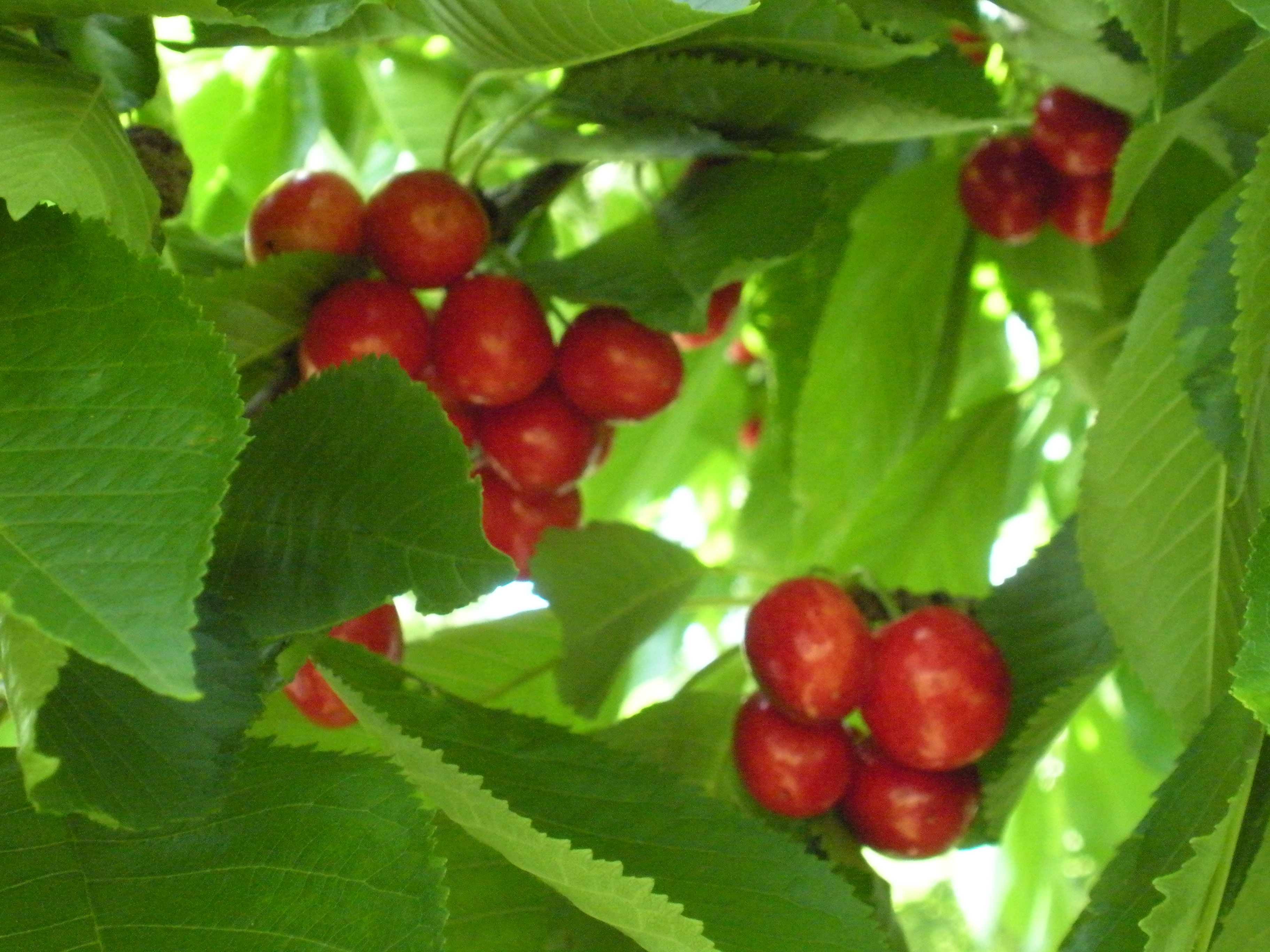
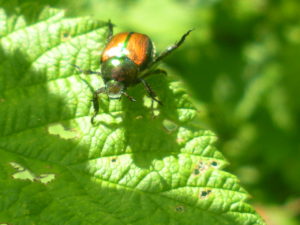
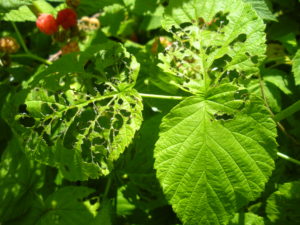
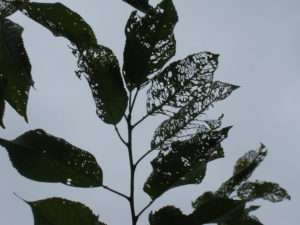

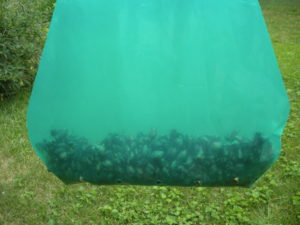
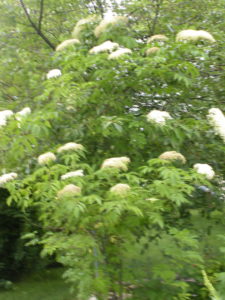

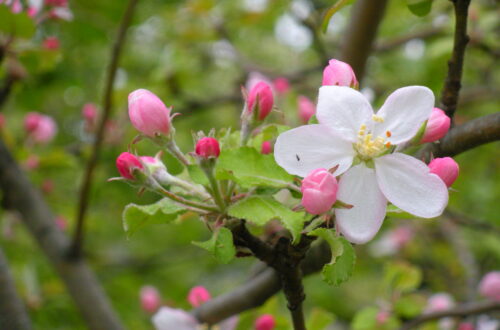
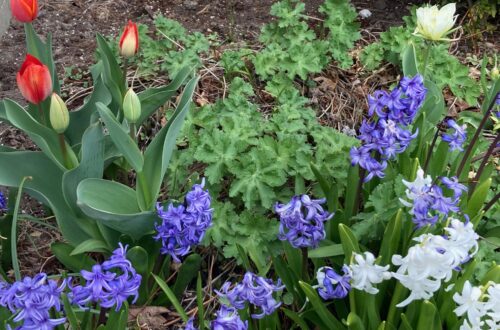
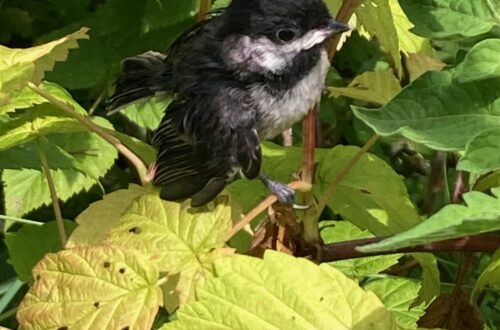
Wow! What a blessing to have all those berries growing on your property! That is a goal of ours! Thank you for sharing with us on the Art of Home-Making Mondays at Strangers & Pilgrims on Earth! 🙂
Can I buy a trap through your site? (Or where?)
I bought mine off the internet. Look up Bonide Beetle Bagger. The package includes the lure, the lure holder and two disposable collection bags. I had a 5 foot plant hanger–a sturdy pole with a hook that I placed away from my tree and bushes–to hang the device on. We have been taking the bag off each day, soaking it in soapy water (so the beetles all die) and emptying it. Then we rinse it with plain water and put it back up. So we are still using the first bag.
Hello Carol and welcome to Nature Notes, I am happy to have you link in. I have these beetles too, but fewer and fewer them. I know they start as grubs in the lawn and something is eating them as I have bird feeders and preventing them from maturing…. I found this when looking for organic ways to control them…
Handpicking is essential to limiting Japanese beetle damage. Early season control is particularly helpful because Japanese beetles give off chemical signals when they find good host plants, attracting more beetles. For handpicking, a couple of inches of soapy water in a pail, bowl or jug works well (use plain water if you plan to feed the collected beetles to poultry or pond fish). If you cringe at the thought of touching the beetles, tape a large funnel to the top of a milk jug or other plastic container to use as your collection device. First thing in the morning, hold your chosen container under the leaf or bough where the beetles are feeding, and brush them down into it with your hand. The beetles won’t bite you, and as long as temperatures are cool they will fall into the water rather than flying away. Within an hour, they will drown.
Provide nesting sites for robins, bluebirds and other insect-eating birds. They will seldom nab an adult beetle but will gather a lot of grubs.
Sprinkle diatomaceous earth (DE) in lawn areas near roses and other highly attractive plants.
Do not use Japanese beetle traps within 500 yards of susceptible plants, because they will attract excessive numbers of beetles. However, in areas where Japanese beetles are newly established, intensive neighborhood-wide trapping may reduce problems the following year. The beetles collected in traps can be frozen and fed to chickens or pond fish.
Grow tulip poplars, which host a beneficial Tiphia wasp that parasitizes Japanese beetle grubs.
Carol…I know you have participated in Nature Notes before..welcome back..
neem oil 😁
Thanks, I actually purchased neem oil to use this summer.
Michelle, thank-you for all of the helpful tips! I have become a pro at hand picking, but this year it was totally overwhelming. Out of desperation we ordered a trap. Currently we are getting 400 to 500 beetles in the trap each day. I still go around the yard and pick off any on my plants, but now that is only a few. I do have a lot of robins that frequent my yard, so I am encouraged. I will also sprinkle the diatomaceous earth–does timing matter (should it be fall or spring)?
I will have to look that up Carol. I have never used it myself…just read about it.
Wow! So glad the trap was effective. I hope you are able to treat the grass too. I love the passion and attention you give to your fruit! Blessings to you!
Thanks, Holly!
Those beetles seem to be here year round now, that trap seems like a keeper. Good luck, nasty little bugs.
Ick.
Japanese beetles – pretty but highly destructive.
Thanks for sharing at http://image-in-ing.blogspot.com/2016/07/world-war-ii-memorial-washington-dc.html
That trap looks like it worked wonders. Now find me a method to control guava moth – it attacks every fruit!
Oh a hundred and one things to think about when you like enjoy your berries! Amazing how many beetles you caught with that trap!
Many thanks for sharing that information with SEASONS, Carol:) Your posts are so interesting! Have a great week, Carol:)